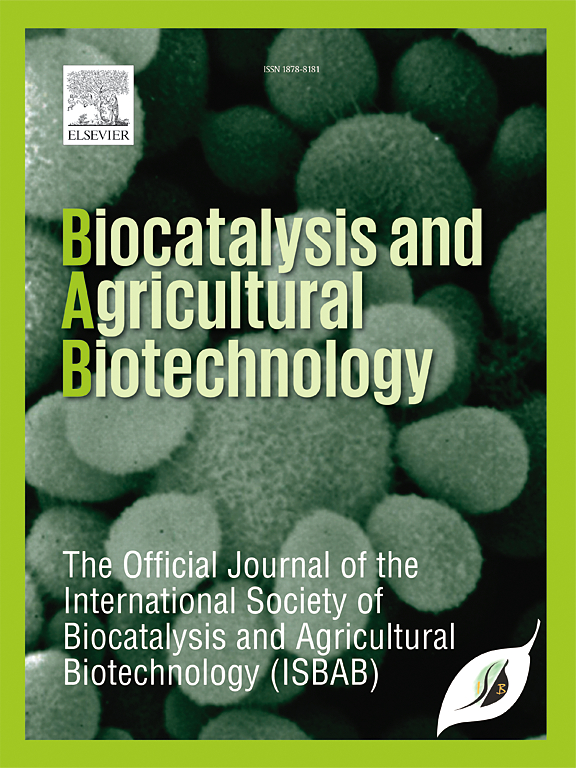IF 3.4
Q2 BIOTECHNOLOGY & APPLIED MICROBIOLOGY
引用次数: 0
摘要
微生物是合成杀虫剂和肥料的一种环境可持续替代品。本研究的重点是从蛭石堆肥茶和一种有机无土栽培甜瓜作物的根瘤菌层中鉴定和筛选出具有在农业中用作生物农药和生物肥料潜力的微生物。评估了这些微生物的生物肥料能力,如固氮、磷酸盐溶解和苷元生产。作为生物农药评估的一部分,还测试了这些微生物对八种细菌和真菌植物病原体的体外拮抗作用。此外,还对所选菌株产生的具有农艺学意义的次生代谢物进行了预测性研究。细菌 Acinetobacter beijerinckii B9、Kocuria palustris B23、Pantoea agglomerans B32、Rahnella aquatilis B21、Streptomyces griseorubiginosus B29 和 Bacillus licheniformis B15,以及真菌 Aspergillus fumigatus H4、Aspergillus niger H6 和 Aspergillus terreus H2 都表现出卓越的生物杀虫和生物肥料活性。其中,所选真菌和丝状菌 S. griseorubiginosus B29 尤为突出,它们产生了许多与抗菌活性和诱导植物防御机制有关的次级代谢产物。这些微生物是替代对环境有害的农用化学品的新型生物解决方案,前景广阔。本文章由计算机程序翻译,如有差异,请以英文原文为准。

Microbial biofertilizers and biopesticides from vermicompost tea and rhizosphere of organic soilless melon crop: In vitro assessment
Microorganisms offer an environmentally sustainable alternative to synthetic pesticides and fertilizers. This study focuses on the identification and selection of microorganisms from vermicompost tea and the rhizosphere of an organic soilless melon crop, with potential for use as biopesticides and biofertilizers in agriculture. The biofertilizing capabilities of these microorganisms, such as nitrogen fixation, phosphate solubilization, and siderophore production, were evaluated. As part of the biopesticide assessment, their in vitro antagonistic effects against eight bacterial and fungal plant pathogens were tested. Additionally, a predictive study on the production of secondary metabolites of agronomic interest was conducted for the selected strains. The bacteria Acinetobacter beijerinckii B9, Kocuria palustris B23, Pantoea agglomerans B32, Rahnella aquatilis B21, Streptomyces griseorubiginosus B29 and Bacillus licheniformis B15, as well as the fungi Aspergillus fumigatus H4, Aspergillus niger H6 and Aspergillus terreus H2 showed excellent biopesticidal and biofertilizer activities. Among these, the selected fungi and the filamentous bacterium S. griseorubiginosus B29 were particularly notable for producing many secondary metabolites associated with antimicrobial activity and the induction of plant defense mechanisms. These microorganisms represent promising novel biobased solutions to replace environmentally harmful agrochemicals.
求助全文
通过发布文献求助,成功后即可免费获取论文全文。
去求助
来源期刊

Biocatalysis and agricultural biotechnology
Agricultural and Biological Sciences-Agronomy and Crop Science
CiteScore
7.70
自引率
2.50%
发文量
308
审稿时长
48 days
期刊介绍:
Biocatalysis and Agricultural Biotechnology is the official journal of the International Society of Biocatalysis and Agricultural Biotechnology (ISBAB). The journal publishes high quality articles especially in the science and technology of biocatalysis, bioprocesses, agricultural biotechnology, biomedical biotechnology, and, if appropriate, from other related areas of biotechnology. The journal will publish peer-reviewed basic and applied research papers, authoritative reviews, and feature articles. The scope of the journal encompasses the research, industrial, and commercial aspects of biotechnology, including the areas of: biocatalysis; bioprocesses; food and agriculture; genetic engineering; molecular biology; healthcare and pharmaceuticals; biofuels; genomics; nanotechnology; environment and biodiversity; and bioremediation.
 求助内容:
求助内容: 应助结果提醒方式:
应助结果提醒方式:


